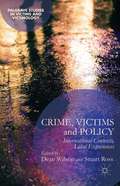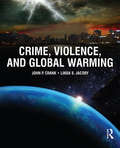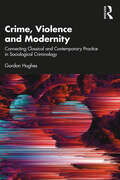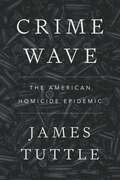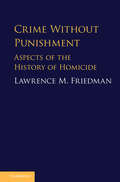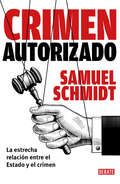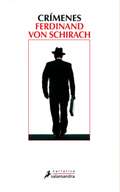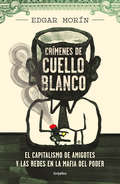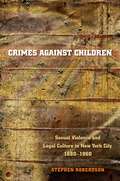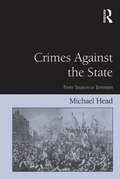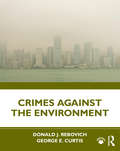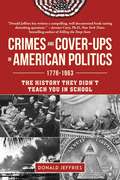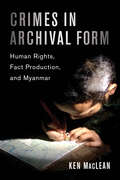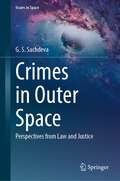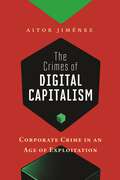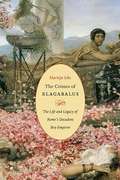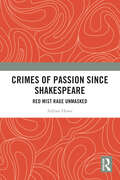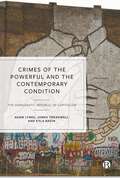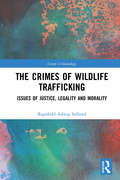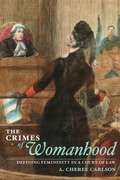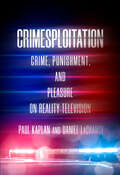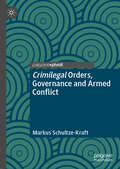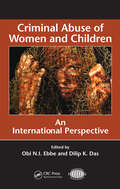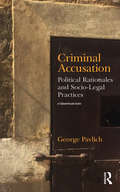- Table View
- List View
Crime, Victims and Policy
by Dean Wilson Stuart RossCrime, Victims and Policy brings together the work of leading international scholars to examine how the experience of victims of crime, and the formulation of policies and theory that impact upon them, are translated and experienced within specific local contexts. The collection examines questions of key concern to scholars interested in the contexts and experiences of 'victims of crime' both within and beyond criminal justice systems. The chapters assembled here cover crucial questions, including the Eurocentric nature of conventional victimological approaches, the limitations of legal definitions of victims, the construction of victim identities, experiences of the criminal justice system, the policy making process and the 'discovery' of new victims. Importantly, a central theme of this collection is how the local contexts of postcolonial societies within the southern hemisphere both reflect and diverge from international developments in victim experience, policy and practice.
Crime, Violence, and Global Warming
by John P. Crank Linda S. JacobyCrime, Violence, and Global Warming introduces the many connections between climate change and criminal activity. Conflict over natural resources can escalate to state and non-state actors, resulting in wars, asymmetrical warfare, and terrorism. Crank and Jacoby apply criminological theory to each aspect of this complicated web, helping readers to evaluate conflicting claims about global warming and to analyze evidence of the current and potential impact of climate change on conflict and crime. Beginning with an overview of the science of global warming, the authors move on to the links between climate change, scarce resources, and crime. Their approach takes in the full scope of causes and consequences, present and future, in the United States and throughout the world. The book concludes by looking ahead at the problem of forecasting future security implications if global warming continues or accelerates. This fresh approach to the criminology of climate change challenges readers to examine all sides of this controversial question and to formulate their own analysis of our planet's future.
Crime, Violence and Modernity: Connecting Classical and Contemporary Practice in Sociological Criminology
by Gordon HughesThis book makes an original contribution to reconnecting criminological inquiry to the core concerns of the classical sociological imagination and to the intellectual resources of comparative and historical sociology. Throughout the book Hughes challenges the long-standing division of labour in criminology and sociology more generally between ‘theory’, ‘method’ and ‘research’. Accordingly, the author’s concerns here are as much about the craft and working methods of being a sociological criminologist as it is about theory and concepts. In the first half of the book, the key conceptual and methodological premises of the classical sociological tradition are outlined and the latter’s potential for revitalizing contemporary criminological research-theorizing are assessed. These chapters also address the debate regarding the relationship between crime and violence, and that of modernity and the Western ‘civilizing process’. In the second half of the book, three areas of current criminological inquiry are explored through the lens of the long-term, process-oriented and radically relational perspective of contemporary Weberian and Eliasian scholarship. Among the areas of comparative investigation explored here are street crime, gangs and urban violence, genocide and murderous ethnic cleansing, warfare, colonialism and human rights. Written in a clear and direct style this book will appeal to students and scholars of criminology, sociology and all those interested in what a sociological lens brings to the practices of contemporary criminology.
Crime Wave: The American Homicide Epidemic
by James TuttleWhy homicides have increasedThe homicide rate in the United States increased by approximately 55 percent from 2014 to 2021. An initial spike in homicide rates began in 2015, and the rate continued on its generally upward trajectory through subsequent years, eventually increasing by the largest annual margin in recorded history during 2020. By 2021, several cities and states recorded homicide rates higher than during the crime-plagued 1990s. Why did America suddenly become more violent?James Tuttle examines the underlying causes behind this surge in violence, arguing that it is the result of the decline in American well-being, a growing distrust in institutions, an increase in alcohol and drug abuse, and escalating firearm sales. Tuttle also shows how the homicide epidemic has hit different parts of the country; notably there has been an increase in homicide in the Midwest that is 25 percent greater than in the rest of the country.Through comprehensive analysis of the most recent crime data available, Tuttle provides compelling evidence supporting these contentions, illuminating the intricate relationship between societal decline and the homicide epidemic. This book builds on evidence that demonstrates the limited impact of police tactics on crime rates, and finds little substantiation for the notion that police department defunding played a role in the rise of crime across American cities. Crime Wave attempts to reframe the public debate beyond the current “police-only” paradigm of explaining crime trends by examining the broader social and cultural forces that shape American violence.
Crime Without Punishment: Aspects Of The History Of Homicide
by Lawrence M. FriedmanIn this compelling book, Lawrence M. Friedman looks at situations where killing is condemned by law but not by social norms and, therefore, is rarely punished. <P><P>He shows how penal codes categorize homicides by degree of intent, which are in turn based on society's sense of moral outrage. Despite being officially defined as murder, many homicides have historically gone unpunished. Friedman looks at early vigilante justice, crimes of passion, murder of necessity, mercy killings, and assisted suicides. In his explorations of these unpunished homicides, Friedman probes what these circumstances tell us about conflicts in social and cultural norms and the interaction of law and society.<P> Asks when, if ever, killing can justifiably be considered as homicide.<P> Connects seemingly different examples of 'crimes without punishment' with historical developments.<P> Links research on the history of criminal justice with the way in which legal systems actually operate in society today.
Crimen autorizado
by Samuel SchmidtEn octubre de 2020 fue detenido en Estados Unidos el exsecretario de la Defensa de Enrique Peña Nieto acusado de narcotráfico y lavado de dinero. Eso es crimen autorizado. En julio de 2020 una juez federal mexicana liberó a un narcotraficante a cambio de 2 millones de dólares. Eso es crimen autorizado. En diciembre de 2019 fue detenido en Estados Unidos el Secretario de Seguridad Pública de Felipe Calderón acusado de colaborar con el Cartel de Sinaloa. Eso es crimen autorizado. En abril de 2019 un candidato presidencial de Guatemala fue apresado en Estados Unidos acusado de solicitar al cártel de Sinaloa fondos para la campaña. Eso es crimen autorizado. En Paraguay los cárteles de la droga penetran los niveles más altos de la policía y logran un narcopresidente. En ese mismo país, la DEA protegía narcotraficantes para hacerlos sus informantes. Eso es crimen autorizado. En Colombia las narcoaportaciones a la campaña presidencial de Ernesto Samper en 1994 lo imposibilitaron para hablar de legalizar la marihuana. Eso es crimen autorizado. La categoría crimen autorizado es un concepto jurídico que alude a la asociación entre criminales y el Estado, configurando una condición estructural que dificulta combatir al crimen y a la corrupción. Esto afecta la gobernabilidad, la legitimidad, arruina el tejido político y expande los beneficios del crimen, causando daños graves a la salud social. En este libro, Samuel Schmidt desarrolla a fondo ese concepto, revelando los impactos sociales, económicos, políticos e ideológicos de la profunda asociación entre los criminales y los distintos componentes del Estado. Además, fiel a su estilo, nos sugiere algunos cursos de acción para librar a la sociedad de esta relación perversa entre crimen y política.
Crímenes
by Ferdinand von SchirachCrímenes plantea el fascinante tema de la escurridiza verdad en los procesos criminales y reflexiona sobre el sentido del castigo. Esta serie de relatos basados en la experiencia profesional del autor, un reputado jurista alemán, se convirtió en uno de los mayores éxitos editoriales de los últimos años en Alemania. Además de obtener el prestigioso Premio Kleist, Crímenes mereció un torrente de elogiosos comentarios de la crítica y ocupó durante casi un año las listas de libros más vendidos. Cerca de setecientos casos desde que inició su carrera de abogado penalista en Berlín son el bagaje de vivencias que Von Schirach ha transformado, con un aguzado instinto narrativo, en una obra literaria de atmósfera cautivadora. El lenguaje sobrio y conciso de la búsqueda de la verdad judicial subraya la atención que Schirach fija en los crímenes cometidos por individuos corrientes, dejando que los hechos expongan la realidad con toda su crudeza. Profundamente original, revelador y lleno de matices, Crímenes nos habla con proximidad del ser humano, de su miseria y también de su grandeza. La crítica ha dicho...«Von Schirach narra con asombroso y conmovedor conocimiento del alma humana historias reales de asesinatos y delincuentes [...] pero lo hace con sobriedad e inteligencia, sin convertir a sus protagonistas en monstruos [...] describe sus acciones con una mirada que se esfuerza por comprender, teñida de piedad y, en algún caso, de ternura.»Jacinto Antón, El País «Schirach escribe con sobriedad, de forma clara y sencilla, como si nunca hubiera hecho otra cosa. Es un soberbio narrador que confía en los personajes y en su destino [...]. Cine escrito en formato breve.»Der Spiegel
Crímenes de cuello blanco: El capitalismo de amigotes y las redes en la mafia del poder
by Édgar MorinLa mafia del poder sigue viva... y lucrando. Este es un libro sobre delitos cometidos por ciudadanos respetados, pero no respetables. Delitos que evidencian la existencia de pactos políticos y de impunidad a gran escala. Este es un libro sobre los crímenes de cuello blanco. Hoy, de hecho, la política y la alta empresa mexicana no se entienden sin este "capitalismo de amigotes", basado en favores, lazos de sangre, desigualdades y protección gubernamental. Y el daño financiero de esos crímenes es mucho más grande que el de toda la delincuencia "clásica". En esta obra, con nombres y apellidos, se muestra quiénes integran esas redes de privilegio, en qué negocios están metidos y qué historias arrastran. ¿Lo más impresionante? Que esa "mafia del poder" sigue operando, y algunos de sus integrantes tratan de incorporarse a las actuales esferas gubernamentales.
Crimes against Children
by Stephen RobertsonIn the first half of the twentieth century, Americans' intense concern with sex crimes against children led to a wave of public discussion, legislative action, and criminal prosecution. Stephen Robertson provides the first large-scale, long-term study of how American criminal courts dealt with the prosecution of sexual violence against children.Robertson describes how the nineteenth-century approach to childhood as a single phase of innocence began to shift at the end of the century to include several stages of childhood development, prompting reformers to create legal categories such as statutory rape and carnal abuse to protect children. However, while ordinary New Yorkers' involvement in the prosecution of those offenses reshaped their understandings of who was a child and produced a new concern to establish the age of their sexual partners, their beliefs in childhood innocence and in a concept of sexuality centered on sexual intercourse remained unchanged. As a result, families' use of the law and jurors' decisions ultimately diminished the protection the new laws offered to children. Robertson's study, based on the previously unexamined files of the New York County district attorney's office, reveals the importance of child sexuality and sex crimes in twentieth-century American culture.
Crimes Against Humanity: Historical Evolution and Contemporary Application
by M. Cherif BassiouniThis book traces the evolution of crimes against humanity (CAH) and their application from the end of World War I to the present day, in terms of both historic legal analysis and subject-matter content. The first part of the book addresses general issues pertaining to the categorization of CAH in normative jurisprudential and doctrinal terms. This is followed by an analysis of the specific contents of CAH, describing its historic phases going through international criminal tribunals, mixed model tribunals and the International Criminal Court. The book examines the general parts and defenses of the crime, along with the history and jurisprudence of both international and national prosecutions. For the first time, a list of all countries that have enacted national legislation specifically directed at CAH is collected, along with all of the national prosecutions that have occurred under national legislation up to 2010.
Crimes Against The State: From Treason to Terrorism
by Michael HeadIn the post-2001 context of economic and political conflict, this book presents a timely and detailed examination of the role of the criminal law in the protection of the existing order from political dissent and destabilization. It reviews offences such as rebellion, treason, mutiny, espionage, sedition, terrorism, riot and unlawful assembly in the UK, US, Canada and Australia from a comparative perspective and investigates leading cases in their historical and political contexts. Also examining the impact on human rights and civil liberties, this book covers a neglected area of English-derived law and will encourage debate about crimes against states and governments.
Crimes Against the Environment
by Donald J. Rebovich George E. CurtisCrimes Against the Environment explains the seriousness of the threat posed by pollution, its roots, how it has evolved, how it differs across the planet, and how society has endeavored to create and enforce laws directed at its control. Rebovich and Curtis begin with an overview of hazardous waste, the industries that produce toxins, available methods of waste treatment, and the legal environment of environmental crime. They examine the forces driving criminal behavior and the methods offenders adopt, as well as protections against polluters and their effectiveness. The book concludes with an examination of environmental justice in the United States and globally, and looks ahead to the future of crime control and prevention in this arena. Case studies and discussion questions offer further perspective on these challenging issues of environmental integrity. This text serves undergraduate or early-stage graduate students majoring in criminal justice, environmental science, sociology, and political science, and could also serve as a resource for professionals in environment-related occupations.
Crimes and Cover-ups in American Politics: 1776-1963
by Donald JeffriesThe history that the textbooks left out. For far too long, American history has been left in the unreliable hands of those that author Donald Jeffries refers to as the court historians. Crimes and Cover-ups in American Politics: 1776-1963 fights back by scrutinizing the accepted history of everything from the American War of Independence to the establishment reputation of Thomas Jefferson and the other Founding Fathers, the Civil War, the Lincoln assassination, both World Wars, US government experimentation on prisoners, mental patients, innocent children and whole populated areas, the Lindbergh baby kidnapping and much, much more. Secular saints like Abraham Lincoln, Theodore Roosevelt, and Franklin D. Roosevelt are examined in a critical way they seldom have been. Jeffries spares no one and nothing in this explosive new book. The atrocities of Union troops during the Civil War, and Allied troops during World War II, are documented in great detail. The Nuremberg Trials are presented as the antithesis of justice. In the follow-up to his previous, bestselling book Hidden History: An Expose of Modern Crimes, Conspiracies, and Cover-Ups in American Politics, Jeffries demonstrates that crimes, corruption, and conspiracies didn't start with the assassination of President John F. Kennedy. History should be much more than cardboard villains and impossibly unrealistic heroes. Thanks to the efforts of the court historians, most Americans are historically illiterate. Crimes and Cover-ups in American Politics: 1776-1963 is a bold attempt at setting the record straight.
Crimes in Archival Form: Human Rights, Fact Production, and Myanmar
by Prof. Dr. Ken MacLeanCrimes in Archival Form explores the many ways in which human rights "facts" are produced rather than found. Using Myanmar as his case study, Ken MacLean examines the fact-finding practices of a human rights group, two cross-border humanitarian agencies, an international law clinic, and a global NGO-led campaign. Foregrounding fact-finding, in critical yet constructive ways, prompts long overdue conversations about the possibilities and limits of human rights documentation as a mode of truth-seeking. Such conversations are particularly urgent in an era when the perpetrators of large-scale human rights violations exploit misinformation, weaponize disinformation, and employ outright falsehoods, including deepfakes, to undermine the credibility of those who document abuses and demand accountability in the court of public opinion and in courts of law. MacLean compels practitioners and scholars alike to be more transparent about how human rights "fact" production works, why it is important, and when its use should prompt concern.
Crimes in Outer Space: Perspectives from Law and Justice (Issues in Space)
by G. S. SachdevaThis book flags and contemplates the lurking problem of space crimes that may escalate and expand with diversification of space activities, greater footfall on the celestial bodies and passage of time, for the lack of appropriate solutions. It appraises the incumbent problems to evolve solutions and make recommendations regarding space crime situations. Recognizing current situation where commercial space travel has commenced, and space tourism is not far behind, the book takes a pole position on discussing the topic with its endemic challenges. Space transportation is expected to lead to commercial mining of celestial mineral resources from the Moon and asteroids, as has been found technically feasible and commercially viable. Space-specific products have been identified for industrial mining, processing, and manufacturing, for which manpower would be necessary, howsoever minimal, despite artificial intelligence devices. Blueprints for space habitations on the Moon and Mars are being prepared. In this scenario, where outer space and celestial bodies may soon be inhabited by multi-nationality, multi-ethnic and multi-cultural groupings of tourists, workers, and residents, given cramped and not so comfortable or private living spaces, attitudinal disparities and conflicting beliefs, differences, disputes, conflicts, and crimes are sure to raise their head. Economic activity and business culture may usher in crimes of competition and spying on intellectual property. Space crimes through technologies like cyber, lasers, etc., may also permeate the space domain for ill-intentioned abuses. The criminals may be individuals or collective groups or incognito terrorists. The book also discusses crimes and near-crimes that have already occurred in space but have been ignored or condoned. Absence of sovereignty on celestial bodies coupled with crimes in space or on celestial bodies, presents problems of jurisdiction, extradition, and other legal procedures. The dilemma of multi-national judicial systems, legal codes and norms of social justice need to be resolved by a specialized treaty reconciling major bends in the existing system vis-à-vis the nature of space crimes. Limitations in handling such crimes by the existing judicial system under established doctrines of international law by International Court of Justice or International Criminal Court, is highlighted in the book. It has strong take-aways for research scholars, law fraternity, diplomatic corps, judicial administration, policy-makers and the political class, enabling them to pro-actively initiate action for suitable answers.
The Crimes of Digital Capitalism: Corporate Crime in an Age of Exploitation (Justice, Inequality, and the Digital World)
by Aitor JiménezHow technology companies profit from our increasing dependence on digital infrastructure and the privatization of dataThe Crimes of Digital Capitalism proposes the first comprehensive theory of corporate crime for the digital age. Aitor Jiménez explores the criminal structure of digital capitalism fostered by states and corporations along the supply chain, illustrating how the rise of algorithmic racism, the Googlization of education, and the deployment of AI surveillance/killing technologies brutally impacts the lives of millions of people around the world.Under the label of digital capitalism, argues Jiménez, lives a system of exploitation that, standing on digital technologies, is pushing the neoliberal project into an entirely new dimension of practices and exploitative policies with its own set of socially harmful consequences. Digital capitalism has accelerated the neoliberal attack on labor rights, expanded previous forms of exploitation, and developed new ways of surveilling and controlling workers. Delving into the structural relation between capitalism and corporate crime in the digital age, The Crimes of Digital Capitalism argues that the massive social harms caused by large technology companies and states should not be seen as accidental by-products, but as criminal strategies necessary for the existence of digital capitalism.Linking the debates on the platform economy to today’s most pressing social justice issues, this deeply interdisciplinary book connects complex ideas around digital capitalism to everyday problems.
The Crimes of Elagabalus: The Life and Legacy of Rome's Decadent Boy Emperor
by Martijn IcksThe four short years of Elagabalusâs rule have generated nearly two millennia of sustained attention, from salacious rumor to scholarly analysis to novels that cast him as a gay hero avant la lettre. Here, Martijn Icks succeeds in distinguishing the reality of the emperorâs brief life from the myth that clouds itâand in tracing the meaning of the myth itself to the present day. In 219 ce, when the fourteen-year-old Syrian arrived in Rome to assume the throne, he brought with him a conical black stone, which he declared was the earthly form of the sun god El-Gabal, who gave Elagabalus his name and lifelong office as high priest. Shoving Jupiter aside, the new emperor did the unthinkable, installing El-Gabal at the head of the Roman pantheon and marrying a vestal virgin. Whether for these offenses, his neglect of the empire, or weariness from watching the emperor dance at the elaborate daily sacrifices, the imperial guards murdered Elagabalus and put El-Gabal in a packing crate. Sifting through later accounts of the emperorâs outrageous behavior, Icks finds the invented Elagabalus as compelling as the historical figure. In literature, art, and music from the fifteenth century on, Elagabalus appears in many guises, from evil tyrant to anarchist rebel, from mystical androgyne to modern gay teenager, from decadent sensualist to pop star. These many reincarnations reveal as much about the ages that produced them, Icks shows, as they do about the bad-boy emperor himself.
Crimes of Passion Since Shakespeare: Red Mist Rage Unmasked
by Adrian HoweBringing key Shakespeare texts into dialogue with feminist socio-legal research, this book investigates the notion of a ‘crime of passion’ – indicatively, wife-killing. Its key concern is to bring attention to a cultural and legal revolution widely overlooked even in the law field where it occurred. In 2009, the English Parliament passed a controversial law abolishing the defence of provocation. Explaining the new law, reformers said that this so-called ‘heat of passion’ defence had allowed men to get away with murder by blaming the victim. Abolishing it in cases of alleged ‘infidelity’ would ‘end the culture of excuses’. Unpacking what was at stake in the reformers’ revolutionary challenge to the English law of murder’s age-old concession to ‘human frailty’ in ‘red mist’ rage cases, this book charts passion’s progress in wife-killing cases over the centuries. It commences in the early modern era when jurists were busy distinguishing murder from manslaughter and, contemporaneously, Shakespeare set about querying culturally inscribed excuses for femicide in his plays, Titus Andronicus and Othello. This book will appeal to feminist and socio-legal scholars, criminologists and those working in the fields of law and literature, legal theory and Shakespeare studies. More widely, it will appeal to anyone interested in so-called ‘crimes of passion’.
Crimes of the Powerful and the Contemporary Condition: The Democratic Republic of Capitalism
by James Treadwell Adam Lynes Kyla BavinThe ultimate expression of power is the ability to act beyond the confines of law, with contemporary society enabling elite groups to wield “panoramic power”. From the murderous crimes of the corporate giants that provide us with life’s luxuries and necessities to the data gathering activities of media and educational institutions, the authors offer new thinking on damaging structures of power and privilege. This accessible book provides a comprehensive understanding of elite corporate wrongdoing, and the late capitalist society that enables harm, considering both how we got into this mess and how we get out of it.
The Crimes of Wildlife Trafficking: Issues of Justice, Legality and Morality (Green Criminology)
by Ragnhild Aslaug SollundThis book examines trade and trafficking in endangered animal species and how the trade increasingly puts large numbers of nonhuman species at risk. Focusing on illegal trafficking, the book also discusses the harmful aspects of the trade and trafficking which is taking place in concordance with laws and regulations. Drawing on the findings of empirical research from Norway and Colombia, the study discusses how this global, transnational trend is addressed, and features of the trade and the ways in which it is controlled in the two case study locations. It also explores the motives driving the trade, and the consequences in terms of animal abuse and environmental harm. The book discusses whether internationally agreed measures, such as international conventions, actually help prevent the trade. Possible ways to address the harms of wildlife trade are considered, including a total ban. The work draws on a green criminology and eco feminist theoretical framework to provide a broad perspective on concepts such as harm, animal rights, species justice and speciesism.
The Crimes of Womanhood: Defining Femininity in a Court of Law
by A. Cheree CarlsonCultural views of femininity exerted a powerful influence on the courtroom arguments used to defend or condemn notable women on trial in nineteenth-century and early-twentieth-century America. A. Cheree Carlson analyzes the colorful rhetorical strategies employed by lawyers and reporters in the trials of several women of varying historical stature, from the insanity trials of Mary Todd Lincoln and Lizzie Borden's trial for the brutal slaying of her father and stepmother, to lesser-known trials involving insanity, infidelity, murder, abortion, and interracial marriage. Carlson reveals clearly just how narrow was the line that women had to walk, since the same womanly virtues that were expected of them--passivity, frailty, and purity--could be turned against them at any time. With gripping retellings and incisive analysis, this book will appeal to historians, rhetoricians, feminist researchers, and anyone who enjoys courtroom drama.
Crimesploitation: Crime, Punishment, and Pleasure on Reality Television (The Cultural Lives of Law)
by Daniel LaChance Paul Kaplan"Due to the graphic nature of this program, viewer discretion is advised." Most of us have encountered this warning while watching television at some point. It is typically attached to a brand of reality crime TV that Paul Kaplan and Daniel LaChance call "crimesploitation": spectacles designed to entertain mass audiences by exhibiting "real" criminal behavior and its consequences. This book examines their enduring popularity in American culture. Analyzing the structure and content of several popular crimesploitation shows, including Cops, Dog: The Bounty Hunter, and To Catch a Predator, as well as newer examples like Making a Murderer and Don't F**K with Cats, Kaplan and LaChance highlight the troubling nature of the genre: though it presents itself as ethical and righteous, its entertainment value hinges upon suffering. Viewers can imagine themselves as deviant and ungovernable like the criminals in the show, thereby escaping a law-abiding lifestyle. Alternatively, they can identify with law enforcement officials, exercising violence, control, and "justice" on criminal others. Crimesploitation offers a sobering look at the depictions of criminals, policing, and punishment in modern America.
Crimilegal Orders, Governance and Armed Conflict
by Markus Schultze-KraftComprehensively laying out the concept of crimilegality, this book presents a novel perspective on the relationship between what is conventionally termed organised crime and political order in the contemporary developing world. In hybrid crimilegal orders the moral, normative and social boundaries between legality and illegality-criminality are blurred, and through the violation of the official law, the illegal-criminal sphere of social life becomes legitimate and morally acceptable, while the legal turns illegitimate and immoral. Several examples of crimilegality and crimilegal governance in Colombia and Nigeria, including in relation to armed conflict termination, are used to illustrate these complex processes.
Criminal Abuse of Women and Children: An International Perspective (International Police Executive Symposium Co-Publications)
by Obi N.I. Ebbe Dilip K. DasThe abuse of women and children transcends geographical boundaries as well as economic, cultural, religious, political, and social divisions. Comprised of the work of more than 20 academics and practitioners from around the world, Criminal Abuse of Women and Children documents the atrocities that have been committed against these victims from ancie
Criminal Accusation: Political Rationales and Socio-Legal Practices
by George PavlichAccusing someone of committing a crime arrests everyday social relations and unfurls processes that decide on who to admit to criminal justice networks. Accusation demarcates specific subjects as the criminally accused, who then face courtroom trials, and possible punishment. It inaugurates a crime’s historical journey into being with sanctioned accusers successfully making criminal allegations against accused persons in the presence of authorized juridical agents. Given this decisive role in the production of criminal identities, it is surprising that criminal accusation has received relatively short shrift in sociological, socio-legal and criminological discourses. In this book, George Pavlich redresses this oversight by framing a socio-legal field directed to political rationales and practices of criminal accusation. The focus of its interrogation is the truth-telling powers of an accusatory lore that creates subjects within the confines of socially authorized spaces. And, in this respect, the book has two overarching aims in mind. First, it names and analyses powers of criminal accusation – its history, rationales, rites and effects – as an enduring gateway to criminal justice. Second, the book evaluates the prospects for limiting and/or changing apparatuses of criminal accusation. By understanding their powers, might it be possible to decrease the number who enter criminal justice’s gates? This question opens debate on the subject of the book’s final section: the prospects for more inclusive accusative grammars that do not, as a reflex, turn to exclusionary visions of crime and vengeful, segregated, corrective or risk-orientated punishment. Highlighting how expansive criminal justice systems are populated by accusatorial powers, and how it might be possible to recalibrate the lore that feeds them, this ground-breaking analysis will be of considerable interest to scholars working in socio-legal research studies, critical criminology, social theory, postcolonial studies and critical legal theory.
